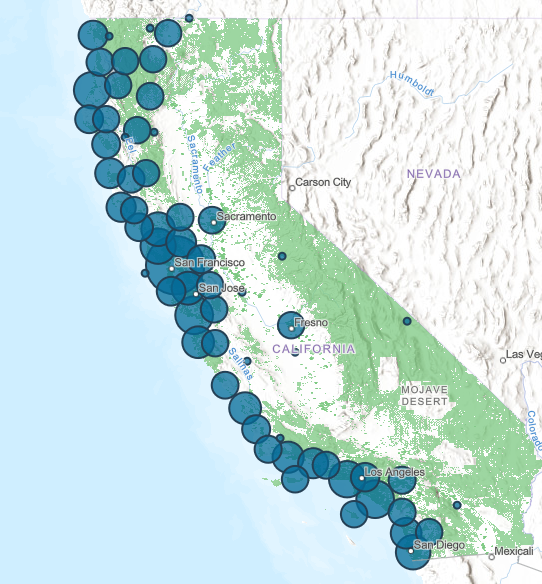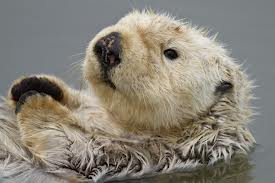Climate Ready Program
The Coastal Conservancy’s Climate Ready Program is helping natural resources and human communities along California’s coast and San Francisco Bay adapt to the impacts of climate change. The Conservancy is also working to capture greenhouse gases from the atmosphere through the conservation of natural and working lands. The Conservancy seeks to support multi-benefit projects that use natural systems to assist communities in adapting to the impacts of climate change.
Climate Ready Projects funded by the Greenhouse Gas Reduction Fund
The 2018 and 2019 Climate Ready grant rounds were funded through the Greenhouse Gas Reduction Fund (GGRF). There will not be a 2020 Climate Ready grant round through the GGRF. Past grant rounds supported multi-benefit projects that use natural systems to enhance resilience to climate impacts. The most recent round focused on managed retreat and natural shoreline infrastructure strategies to increase California’s resiliency to sea level rise, and the 2018 round also funded urban greening and carbon farming projects. The Climate Ready program has used 61% of GGRF funds to support Low Income or Disadvantaged Communities as defined by the CA Air Resources Board, well above the GGRF-wide goal of 35%. The Conservancy provides scoring criteria in all Requests for Proposals including Climate Ready projects.
Who is eligible?
Eligible grantees include government agencies, non-profit organizations, and federally recognized tribes. For more information on project eligibility criteria, please see the Project Selection page.
What is the application timeline?
Timelines differ between rounds – please see the Grants page for current opportunities and timelines.
Who can we contact, and how can we access technical assistance?
We recommend contacting the regional manager responsible for your region before applying for any Conservancy grants.
For current grant opportunities, contact information, and information on technical assistance please see our Grants page.
Learn more about the Greenhouse Gas Reduction Fund and California Climate Investments here.
Through its Climate Ready Grant rounds, the Conservancy has awarded over $12 million for 62 projects in total; click here for a list of projects funded. In addition, the Conservancy is working on dozens of other Climate Ready Projects; examples of these projects are provided below.
Sea Level Rise Adaptation Planning
The Conservancy is helping many communities assess the vulnerability of their communities and natural resources to sea level rise and create adaptation plans to counter threats of sea level rise. We fund technical tools and studies that help understanding and planning for sea level rise impacts.
The Conservancy is helping to plan, design, and implement living shorelines throughout the state that use oyster beds, wetlands, dunes, and other natural habitats to buffer the impacts of rising seas and increased storm events while providing multiple benefits.
Rangeland and Agricultural Adaptation
The Conservancy is helping rangeland and agricultural lands adapt to changing climates including grazing operations, grassland restoration, and water and soil conservation projects such as water catchments and storage design.
Climate change has been driven by greenhouse gas (GHG) emissions into the atmosphere and the Conservancy is working to protect natural and working lands that remove and capture these gases in photosynthesis. Projects include acquisitions of coastal forests, wetland restoration, carbon banking, and carbon farming.
Global warming, drought, and runoff from extreme storms threaten the well-being of millions of urban residents. Conservancy funding is supporting inner-city projects that are creating shady retreats for residents, conserving rainwater, capturing stormwater pollution, and reducing air temperatures.
The Climate Ready Program supports projects that achieve the following purposes:
- Use nature-based solutions that provide co-benefits for people, wildlife, and the economy.
- Promote collaboration among various stakeholders and multiple sectors. Establish and expand non-traditional alliances to accelerate effective problem-solving between and among public and private resource managers, scientists, and decision-makers.
- Reduces GHG emissions or enhances the ability of natural systems to sequester greenhouse gases.
- Address the needs of low-income and other underserved coastal populations that will be highly impacted by climate change.
- Promote on-the-ground demonstration projects that implement innovative approaches or enhance understanding of effective coastal management strategies and will potentially lead to broader change to policies, regulations, or to duplicating the effort elsewhere.
- Incorporates outreach or educational component.
The Climate Ready Program endorses the following strategies in planning for climate change:
- Incorporate the best available science by utilizing peer-reviewed and well-documented climate science, climate adaptation strategies, sea level rise projections, and management practices.
- Focus on future climatic and ecological conditions for coastal communities rather than the past.
- Maximize short and long term public benefits and capitalize on the inherent abilities for natural coastal systems to adapt to change.
- Design actions from a landscape, ecosystem, and watershed perspective on a regional scale.
- Account for a high degree of uncertainty by developing and implementing strategies that provide the greatest benefits across a range of possible future climate and sea level rise scenarios.
Climate Change News
- Press Release: State, Regional Agencies Join Forces to Prepare Bay Area for Sea Level Rise, Increased FloodingMemorandum Marks Commitment to Coordinated Efforts SAN FRANCISCO, July 22, 2024… Seven regional and state public agencies have executed a new memorandum of understanding committing each agency to a joint work program to address increased threats of flooding and sea level rise in the nine-county San Francisco Bay Area region. The agencies participating in the […] (Read more on Press Release: State,...)
- Coastal Conservancy Awards Grants for Coastal Access, Restoration, and Climate Resilience2/15/2024 – Today, the Board of the State Coastal Conservancy authorized a number of grants to restore, protect, and expand access to the California coast. Grants approved included: A grant of an amount not to exceed $35,000,000 to The Nature Conservancy to complete permitting and implement the first phase of the Ormond Beach Restoration Public Access […] (Read more on Coastal Conservancy Awards...)
- Press Release: State Coastal Conservancy Announces Awards for Coastal Resilience, Public Access, Restoration, and StorytellingSan Luis Obispo – This week, the California State Coastal Conservancy announced more than $39 million in funding for projects to improve public access, climate resilience, habitat values, and inclusion at the coast. “The Coastal Conservancy’s vision is of a beautiful, restored, and accessible coast for current and future Californians. To achieve this, we […] (Read more on Press Release: State...)

 Help Save Sea Otters at Tax Time
Help Save Sea Otters at Tax Time

